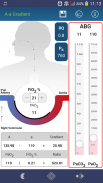




A/a Gradient

Beschreibung von A/a Gradient
The variables in this App. are :
RQ :Respiratory Quotient (approx 0.8 at normal physiological state)
PB : Atmospheric pressure.(760 mm Hg at sea level.)
FiO2 : Fraction of Inspired Oxygen. (0.21 at room air.)
PAO2 : Alveolar Oxygen tension
PaO2 : Arterial oxygen tension
These can be independently changed and the reflection of these changes can be seen in the alveolar – arteriolar gradient and PaO2 / FiO2 ratio.
A-a oxygen gradient : The alveolar arterial (A–a) oxygen gradient is a measure of oxygen transfer across alveolar capillary membrane (“A” denotes alveolar and “a” denotes arterial oxygenation). It is the difference between the alveolar and arterial oxygen tension.
A-a oxygen gradient = PAO2 - PaO2.
PaO2 is derived from ABG while PAO2 is calculated.
PAO2 = (FiO2 x [PB - PH2O]) - (PaCO2 ÷ RQ)
[PH2O is the partial pressure of water (47 mm Hg)] & PaCO2 is partial pressure of Carbon di oxide in arterial blood.
A-a gradient varies with age and can be estimated from the following equation, assuming the patient is breathing room air.
A-a gradient = 2.5 + 0.21 x age in years.
A-a gradient increases with higher FiO2.
PaO2/FiO2 ratio : It is a measure of Oxygen transfer across the alveolar capillary membrane. Normal PaO2/FiO2 ratio is 300 to 500 mmHg. Values less than 300 mmHg indicating impaired gas exchange and values less than 200 mmHg indicates severe hypoxemia.
"Alveolar arterial membrane is depicted in this App. as a BLACK LINE (This is purely a conceptual representation of ventilation-perfusion relationship).The thickness of this Black Line is shown to vary depending on the variations in A-a gradient"
Die Variablen in diesem App. gibt :
RQ: Respiratory Quotient (ca. 0,8 bei normalen physiologischen Zustand)
PB: Luftdruck (760 mm Hg auf Meereshöhe.).
FiO2: Fraktion des eingeatmeten Sauerstoffs. (0,21 bei Raumluft.)
PAO2: alveoläre Sauerstoff-Partialdruck
PaO2: arterielle Sauerstoffspannung
Diese können unabhängig voneinander geändert werden, und die Reflexion dieser Veränderungen in der alveolären sehen - arteriolären Gradienten und PaO2 / FiO2-Verhältnis.
Aa Sauerstoffgradienten Der alveoläre arteriellen (A-a) Sauerstoffgradienten ist ein Maß der Sauerstofftransfer durch alveoläre Kapillarmembran ("A" bezeichnet alveolären und "a" zeigt den arteriellen Oxygenierung). Es ist der Unterschied zwischen dem alveolären und arterielle Sauerstoffspannung.
A-a Sauerstoffgradienten = PAO2 - PaO2.
PaO2 von ABG abgeleitet, während PAO2 berechnet.
PAO2 = (FiO2 x [PB - PH2O]) - (PaCO2 ÷ RQ)
[PH2O ist der Partialdruck von Wasser (47 mm Hg)] & PaCO2 wird Partialdruck des Kohlenstoff di oxid im arteriellen Blut.
Aa Gradienten variiert mit dem Alter und kann aus der folgenden Gleichung berechnet werden, vorausgesetzt, der Patient atmet Raumluft.
A-Gradient = 2,5 + 0,21 x Alter in Jahren.
A-a Gradienten steigt mit höheren FiO2.
PaO2 / FiO2-Verhältnis: Es ist ein Maß für den Sauerstoffaustausch über die alveoläre Kapillarmembran. Normale PaO2 / FiO2 Verhältnis 300 bis 500 mmHg. Werte von weniger als 300 mmHg anzeigt, beeinträchtigt den Gasaustausch und Werte von weniger als 200 mmHg anzeigt schweren Hypoxämie.
"Alveolar arteriellen Membran wird in dieser App dargestellt. Als schwarze Linie (Dies ist eine reine konzeptionelle Darstellung Ventilations-Perfusions-Verhältnis) .Die Dicke dieser Black Line dargestellt ist, abhängig von den Schwankungen der Aa Gradienten zu ändern"

























